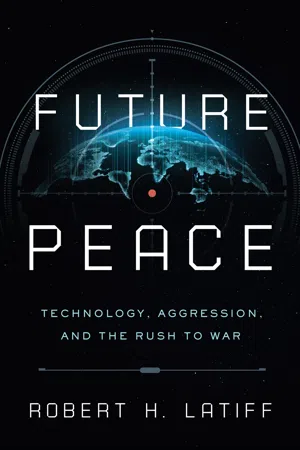![]()
NOTES
PREFACE
1. Marinus Ossewaarde, “Crises of Modernity Discourses and the Rise of Financial Technologies in a Contested Mechanized World,” Philosophy and Technology, no. 31 (2018): 60.
2. Michael A. Cacciatore, Haley Madden, Molly J. Simis, and Sara K. Yeo, “The Lure of Rationality: Why Does the Deficit Model Persist in Science Communication?,” Public Understanding of Science 25, no. 4 (2016): 402.
INTRODUCTION
1. Melissa Girard, “How Autocratic Our Country Is Becoming: The Sentimental Poetess at War,” Journal of Modern Literature 32, no. 2 (2009): 59.
2. Lawrence Sondhaus, “Civilian and Military Power,” International Encyclopedia of the First World War, August 25, 2015, https://encyclopedia.1914-1918-online.net/article/civilian_and_military_power.
3. Robert Weldon Whalen, “War Losses (Germany),” International Encyclopedia of the First World War, October 8, 2014, https://encyclopedia.1914-1918-online.net/article/war_losses_germany.
4. Chris Hedges, “What Every Person Should Know about War,” New York Times, July 6, 2003.
5. Watson Institute, “Costs of War,” Brown University, accessed September 9, 2019, https://watson.brown.edu/costsofwar/.
6. John Arquilla, “The Big Kill,” Foreign Policy, December 3, 2012.
7. John Gray, “Steven Pinker Is Wrong about Violence and War,” The Guardian, March 13, 2015.
8. Dylan Thomas Farley, “Objects in Mirror Are Closer Than They Appear,” Real Clear Defense, October 15, 2019.
9. Richard English, Modern War: A Very Short Introduction (Oxford: Oxford University Press, 2013), 6.
10. Ibid., 8.
11. Sean M. Lynn-Jones, “Offense-Defense Theory and Its Critics,” Security Studies 4, no. 4 (Summer 1995): 667.
12. Daniel R. Lake, “Technology, Qualitative Superiority, and the Overstretched American Military,” Strategic Studies Quarterly 6, no. 4 (Winter 2012): 75.
13. Ray Furlong, “The Changing Story of Russia’s ‘Little Green Men’ Invasion,” Radio Free Europe, February 25, 2019, www.rferl.org/a/russia-ukraine-crimea/29790037.html.
14. Zachery Tyson Brown, “Unmasking War’s Changing Character,” Modern War Institute, March 12, 2019, https://mwi.usma.edu/unmasking-wars-changing-character/.
15. Michael Beschloss, Presidents of War (New York: Crown, 2018), 19.
16. Jacquelyn Schneider, Digitally-Enabled Warfare: The Capability-Vulnerability Paradox (Washington, DC: Center for a New American Security, 2016), 4.
ONE. A GIANT ARMED NERVOUS SYSTEM
1. Patrick Tucker, “The Future the U.S. Military Is Constructing: A Giant Armed Nervous System,” Defense One, September 26, 2017, www.defenseone.com/technology/2017/09/future-us-military-constructing-giant-armed-nervous-system/141303/.
2. Daniel Brown and Skye Gould, “The U.S. Has 1.3 Million Troops Stationed around the World—Here Are the Major Hotspots,” Business Insider, August 31, 2017; W. J. Hennigan, “Inside the New American Way of War,” Time, December 11, 2017, 46.
3. David Vine, “Where in the World Is the U.S. Military?,” Politico, July/August 2015.
4. Kristin Bialik, “U.S. Active Duty Military Presence Overseas Is at Its Smallest in Decades,” Pew Research Center, August 22, 2017, www.pewresearch.org/fact-tank/2017/08/22/u-s-active-duty-military-presence-overseas-is-at-its-smallest-in-decades/.
5. GovLoop, The Joint Information Environment (Washington, DC, 2014), 7, www.govloop.com/wp-content/uploads/2014/10/JIE_Guide_FINAL.pdf.
6. Mark Pomerleau and Mike Gruss, “Army Budget Request Adds $1.5B for Network Modernization, C4ISRNET, April 18, 2019, www.c4isrnet.com/it-networks/2019/04/18/army-budget-request-adds-15b-for-network-modernization/.
7. Tucker, “Future the U.S. Military Is Constructing.”
8. Charles Pope, “Goldfein Details Air Force’s Move toward a ‘Fully Networked,’ Multi-domain Future,” US Air Force website, September 17, 2019, www.af.mil/News/Article-Display/Article/1963310/goldfein-details-air-forces-move-toward-a-fully-networked-multi-domain-future/.
9. Robert R. Leonhard, Thomas H. Buchanan, James L. Hillman, John M. Nolen, and Timothy J. Galpin, “A Concept for Command and Control,” Johns Hopkins APL Technical Digest 23, no. 2 (2010): 159.
10. Daniel M. West and John R. Allen, “How Artificial Intelligence Is Transforming the World,” Brookings Institution, April 24, 2018, www.brookings.edu/research/how-artificial-intelligence-is-transforming-the-world/.
11. Zachary S. Davis, Artificial Intelligence on the Battlefield (Livermore, CA: Lawrence Livermore National Laboratory, March 2019), 10.
12. Michael T. Klare, “The US Military Is Preparing for a New War,” The Nation, June 5, 2019.
13. Zac Rogers, “Have Strategists Drunk the ‘AI Race’ Kool Aid?,” War on the Rocks, June 4, 2019, https://warontherocks.com/2019/06/have-strategists-drunk-the-ai-race-kool-aid/.
14. Elsa B. Kania, “Minds at War: China’s Pursuit of Military Advantage through Cognitive Science and Biotechnology,” Prism 8, no. 3 (January 2020): 85.
15. United Nations Department of Economic and Social Affairs, 2018 Revision of World Urbanization Prospects (New York: United Nations, May 26, 2018), 5.
16. Robert N. Townsend, “Tactical Automation on the Battlefield: Who Is in Control?” (master’s thesis, US Army Command and General Staff College, 1992), 8.
17. National Research Council. Realizing the Potential of C4I: Fundamental Challenges (Washington, DC: National Academies Press, 1999), 27.
18. Callum Roberts, “Just How Smart Is an Octopus?,” Washington Post, January 6, 2017.
19. Amanda Gibbs, “Cephalopod Encephalization,” Eukaryon 13 (2017): 49.
20. Michelle Starr, “Octopus Arms Are Capable of Making Decisions without Input from Their Brains,” Science Alert, June 26, 2019, www.sciencealert.com/here-s-how-octopus-arms-make-decisions-without-input-from-the-brain.
21. Frank W. Grasso, “The Octopus with Two Brains: How Are Distributed and Central Representations Integrated in the Octopus Central Nervous System?,” in Ce...
